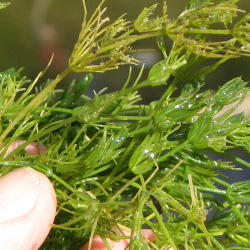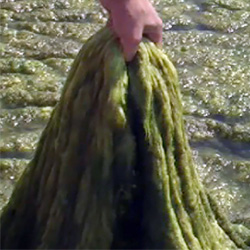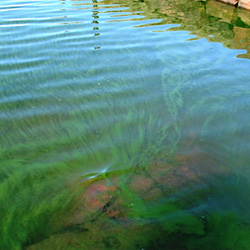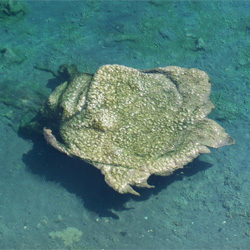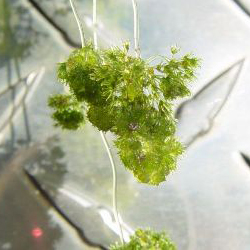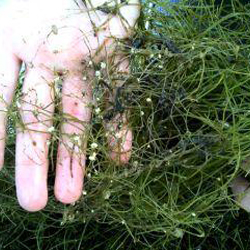Algae
Algae are very primitive plants. Some algae are microscopic (Planktonic algae), others are thin and stringy or hair-like (Filamentous Algae), while still others are large and resemble higher plants but without true roots (chara).
Chara
Because of its size and complex structure, chara is sometimes mistaken for a vascular aquatic plant; however, chara actually is a multi-cellular macro-algae. This submerged, plant-like green algae grows attached to the bottoms of ponds, lakes and slow-moving rivers and ditches. Chara prefers hard, calcium-rich waters. Chara is also known as muskgrass due to its strong, garlic-like odor. This macro-algae has no true leaves, only branches made of single column-shaped cells that are often surrounded by spine-shaped cells. These spiny cells and the calcium deposits that collect on them make the plant somewhat rigid and/or brittle to the touch. Chara can be undesirable in ponds and lakes because it can grow along the bottom of a water body, almost as a carpet, and crowd out other aquatic plant species that may be beneficial to the ecosystem.
Filamentous Algae
There are many different species of filamentous algae, but all have similar growth patterns. Filamentous algae growth begins in the winter and early spring along the bottom in shallow water or attached to rocks, structures or aquatic plants. The single cells in filamentous algae join together into long hair-like strands that grow toward the water surface. By mid-summer these strands form large mats, which trap gases and float to the surface. These floating mats, if left untreated, may cover the entire water body by late summer causing interference with swimming, fishing, boating or recreational water uses. Excessive Algae can also lead to fish kills in late Summer and Fall as dying algae can deplete oxygen within the water body.
Planktonic Algae
Planktonic algae are single-celled, microscopic algae that float in the water column making the water look either green, brown or red in color. Planktonic algae grow very quickly when the conditions are optimal, often resulting in a bloom where the water becomes colored within a day or two. Excessive blooms can cause taste and odor problems in water and sometimes cause a fish kill. These blooms typically disappear in the fall around the first frost when water temperatures drop. The water can stay clear during the winter, but planktonic algae blooms may return in the warmer months.
Lyngbya
Lyngbya is a large-celled, filamentous, mat-forming algae. Lyngbya can grow to be several inches thick, covering large areas of the water surface or sediment. These mats are usually tan, green or black in color and can be improperly identified as dead, floating algae. Mats often float to the surface as trapped gas is expelled from the substrate or decaying algae cells. Lyngbya mats may cover entire cove areas of lakes or the surface of small ponds. Mats can impede navigation and recreation, cover and smother submersed plants and clog water intakes.
Nitella
Nitella is a branched, multi-cellular alga that resembles chara. Nitella has no true leaves but does have slender branches. It does not have flowers and will not extend above the water surface, as it grows mostly in shallow water. Nitella It is not rough to the touch and lacks the garlic-like smell of chara.
a.
Starry Stonewort
This submerged, annual macro-alga invades lakes, ponds, reservoirs and slow moving rivers where it forms dense surface mats that can interfere with recreational activities. Starry stonewort is an invasive species that has established population in the Midwest and Northeast United States. The starry stonewort has whorls of long, narrow branchlets, in groups of 4 to 6, coming off of main shoots. Small, white, star-shaped structures called “bubils” produced at its nodes are a distinguishing feature that gives it the name starry stonewort.

